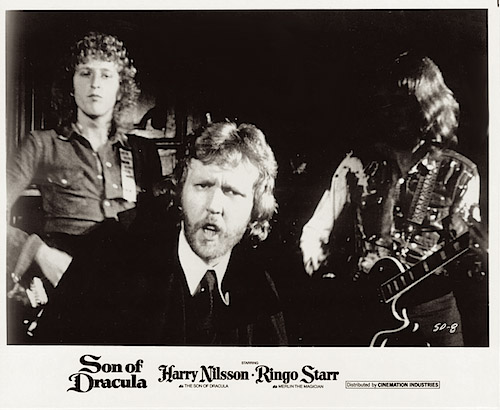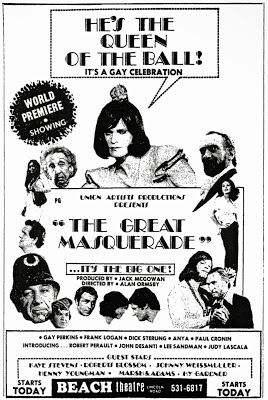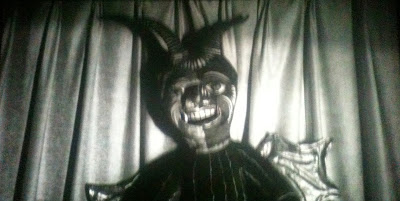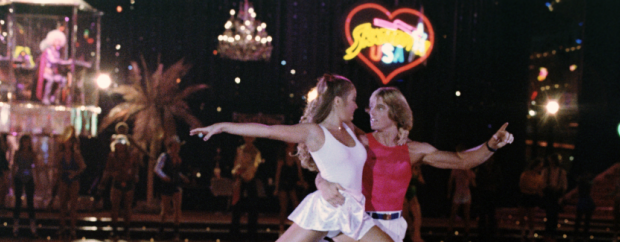In order to understand how the Forgotten Film Festival came into being, it may be helpful to have a bit of background on the gentlemen who put the show together: Exhumed Films. Exhumed was formed in 1997, and since then has screened hundreds of genre and exploitation films in Philadelphia and New Jersey. Particularly impressive is that Exhumed is committed to screening these films on film from 35mm and sometimes 16mm prints. These shows started off as simple horror screenings, then double and triple features, and as their popularity grew Exhumed was eventually able to put together a full 24-hour horror marathon in 2007. The Horrorthon—with its mysterious lineup, never announced in advance—proved to be a massive hit. The success of the Horrorthon inspired Exhumed to start a 12-hour exploitation film show in the Spring, eX-Fest. Their constant search for long-lost gems has now resulted in what is hopefully a new annual show, the Forgotten Film Festival.
The Forgotten Film Festival is exactly what it sounds like: five films (all prints!) that have fallen through the cracks of cinematic history. A few of these films are floating around out there in bootleg formats, taped off HBO in the early 1980s or ripped to a video file from decades-old PAL VHS tapes. None of them have ever seen an official home video release in the States, and in a couple of cases it’s likely they never will. For serious cinephiles and cult/exploitation fans, this was the kind of show that had previously only existed in dreams and fervent wishes, and it did not disappoint.
True to the spirit of the screening, the show began with an introduction from Chris Poggiali of the Temple of Schlock blog, who put each film in context and gave some interesting trivia for the films. Each film also had a short reel of trailers before the film started, mostly on themes similar to the film itself, which also gave the audience a chance to take a break between each feature. After Poggiali’s excellent introduction, the first block of “trailers” played. Like the features, all of the trailers and other material were screened from film prints. The first block included a video of Mick Jagger and David Bowie performing an exceptionally embarrassing version of “Dancing in the Street” to promote Live Aid, the video for “You Better You Bet” by The Who, a “Let’s All Go to the Lobby”-style concession stand commercial with a dancing joint and skating coke razors, and trailers for THE HOLLYWOOD KNIGHTS and ROLLER BOOGIE.
Then the first feature started: SKATETOWN U.S.A. (1979, dir. William A. Levey). Rushed into production to beat ROLLER BOOGIE into theaters and capitalize on the roller disco craze, SKATETOWN U.S.A. is possibly the Platonic Ideal of the rollerskatesploitation film. There’s sort of a story that threads together the footage of people skating and dancing, the “live” performances (Dave Mason inexplicably gets to perform two entire songs on-screen), and the insanely corny vaudevillian comedy bits, but you’d be forgiven for not noticing. Richie (Scott Baio) wants to win the Skatetown, U.S.A. competition, so he enters his friend Stan (Greg Bradford) and Stan’s horny sister Susan (Maureen McCormick) into the contest. What they don’t know is that the contest is always won by Ace (Patrick Swayze in his feature film debut), leader of a tough gang of, uh, disco roller skaters. It sounds ridiculous, but Swayze completely sells it.
SKATETOWN, U.S.A. is extremely dumb, but it’s hugely entertaining. The cast looks like the entire 1970s film and television industry collapsed in on itself: In addition to Baio and McCormick, the cast includes Ron Palilo (“Welcome Back, Kotter”) as Ace’s right-hand man Frankey, Billy Barty as Jimmy, the owner of the rink, Flip Wilson as Harvey (Jimmy’s son) and Jimmy’s wife, Ruth Buzzi as a food critic, Judy Landers working the ticket booth, and even Dorothy Stratten in a cameo appearance as “Girl at the Snack Bar.” The film’s non-stop soundtrack is likely what has kept it from seeing any official home video release. Virtually every second of the movie is accompanied by a huge hit song, some of which aren’t even listed in the ending credits of the film. Fortunately, some theaters around the country have shown SKATETOWN, U.S.A. as a midnight movie, so if you’re lucky enough to have a good rep house in your area, you may catch it on the big screen someday. The print that played here was in fantastic shape, with maybe a tiny bit of color fade, but otherwise it looked great.
The next block of trailers consisted of YOUNG FRANKENSTEIN, THE HUNGER, THE EVIL OF FRANKENSTEIN and ELVIRA, MISTRESS OF THE DARK. These were appropriate choices to lead in to SON OF DRACULA (1974, dir. Freddie Francis). This particular print had one of the film’s alternate titles, YOUNG DRACULA, abruptly inserted into the opening credits on a silent title card (interrupting the song playing over this sequence). Released by Apple Films, SON OF DRACULA stars Ringo Starr as Merlin the Magician and Harry Nilsson as Count Downe, vampire and heir to the throne of the King of the Underworld. Merlin summons Downe to his house for the ceremony in which he will officially be crowned, but Downe is bored with eternal life as a vampire and doesn’t want to take over his father’s mantle. Unsurprisingly, Baron Frankenstein (Freddie Jones) is more than happy to help Downe by performing a surgery that will render Downe mortal, and leave the throne vacant for Frankenstein.

Hammer director Freddie Francis makes SON OF DRACULA look very much like the contemporary British horror films of its day, and the music (mostly songs from Nilsson’s albums Nilsson Schmilsson and Son of Schmilsson) is fantastic, but Ringo Starr and Harry Nilsson are about the last two men on Earth anyone would want to be leads for their film. Starr is his regular goofy self, just in a wizard costume, and Nilsson looks shell-shocked most of the time. During his performance scenes, Nilsson is energetic and engaging, but when he’s not behind a piano he seems to have no idea what to do in front of the camera. This is a major problem in that the film shifts tone drastically almost every few minutes, occasionally wandering into silly comedy and then crashing into scenes meant to be very dramatic. One particularly problematic example of this is when Nilsson’s excellent rendition of “Without You” is completely wasted on a scene that should be the film’s dramatic climax. SON OF DRACULA isn’t quite the disaster that its reputation has suggested, but it’s fairly obvious why no one seems to be in a rush to untangle the rights issues to free it from Apple Films and get it officially released. The print screened here was in very good shape, a little color fade but nothing distracting.
“Daylight,” the only original song written for SON OF DRACULA:
Following SON OF DRACULA in the third trailer block were DRACULA BLOWS HIS COOL, HORROR OF DRACULA with THE THING THAT COULDN’T DIE, a double feature trailer for GRAVE OF THE VAMPIRE (“If the sight of an infant child nursing on human blood will make you sick, do not see this gruesomely explicit horror film.”) and GARDEN OF THE DEAD, and THE KISS OF THE VAMPIRE. Between these trailers was cut some footage from a rare makeup test reel for the film WEREWOLF OF WASHINGTON, which was picture only with no sound (it was instead accompanied by a loud buzzing noise). These trailers led into the first of the Festival’s triple feature of “lost” films, an incredibly rare U.S. theatrical print of BLOOD (1974, dir. Andy Milligan). The only previously available version of BLOOD thought to exist is a truncated 57-minute version released on European VHS in the 1980s. The U.S. theatrical cut runs 69 minutes, making its discovery a huge treat for Milligan fans.
The year is 1884. Dr. Lawrence Orlovsky (Allan Berendt) has returned to the United States with his wife Regina (Hope Stansbury) and his assistants Carrie (Patti Gaul), Orlando (Michael Fischetti) and Carlotta (Pichulina Hempi). Lawrence suspects his father’s accountant Carl Root (John Wallowitch) is stealing from Lawrence’s inheritance and returns to take ownership of his father’s estate so he can continue his experiments to help save his wife from a rare condition that prevents her from being out in the sunlight. But not all is as it seems: Orlovsky’s original family name is Talbot, and Regina’s condition is vampirism, as she is the daughter of Dracula himself! Orlovsky’s research has yielded man-eating plants that somehow allow Regina the ability to spend time in the sun, but the plants are extremely dangerous. Orlando has already lost both his legs to them, and Carrie seems doomed to lose one as well. Their futures are all tied to Orlovsky’s fortune, but time is not on their side. The plants thrive in their new home, and just days after the Orlovskys move in, the neighbors are already suspicious.

BLOOD is one of Andy Milligan’s best and most accessible films. He takes the basic concept of a Universal “monster rally” film and gives it his own very specific flavor: Regina and Lawrence are trapped in their arranged marriage, he constantly trying to find a way to save her from her vampirism and she constantly suspicious of his motives and doubtful of his fidelity. This is a werewolf and vampire movie where the vampire and werewolf are trapped in a loveless marriage, and the werewolf is investigating his accountant for estate fraud with the help of the accountant’s beautiful assistant. Milligan specialized in creating a universe in which every character has severe neuroses, and these problems explode in epic torrents of dialogue, delivered as though each actor is terrified they might not get the line out before it kills them. This overheated style of acting may have been at least partially due to Milligan’s practice of frequently shooting on short ends of film, but it became a hallmark of his work and it hits a peak in BLOOD. Everyone has a lot of information to get out, and even in its 69-minute version BLOOD packs in a lot of Milligan insanity: jealousy, greed, regret, infidelity, incest, murder, man-eating plants, vampires, werewolves, and more. It’s a wild, exhausting ride.
The print screened for the Forgotten Film Festival is a huge improvement over the blurry, chopped European VHS bootleg that was the only way to see the film until now. It showed typical wear of a much-screened grindhouse print, some dirt and emulsion scratches, but the detail is sharp. Color, on the other hand, seemed to vary wildly from shot to shot. The opening credits were very faded and almost entirely pink, but other scenes had plenty of color.
Of most interest to Milligan fans will be what makes up those 12 minutes of previously missing footage. Interestingly, the film does not appear to have been cut for content in the European version, just for time. The opening scene between Orlovsky and real estate agent Markham (Martin Reymert) is considerably longer, and an entire scene is missing from the European version after this opening sequence. After Carrie and Orlando rush Regina into the house and Orlovsky gives her the injection, the theatrical version cuts to a scene in the garden where Orlovsky is shoveling and Regina is sitting under a large umbrella being held by Carrie. This scene helps establish what Orlovsky is doing with the plants to help Regina, and the film flows much better from the opening scene to this and then onto the scenes of Carrie making dinner and clashing with Regina. The scene between Carrie and her brother Johnny is also considerably longer in this version than the UK VHS. All the cuts in the film seem to be designed to bring the film in under an hour, for whatever reason, but recovering any lost Milligan dialogue is exciting. Hopefully now that a print exists, some enterprising home video distributor can make a new version of it for DVD or Blu-ray.
Blood, the entire European VHS cut:
The next set of trailers was for films screening at upcoming Exhumed Films events: CANNIBAL HOLOCAUST (playing with MAN FROM DEEP RIVER on August 7th) and DUNE (playing with STAR TREK III: THE SEARCH FOR SPOCK on August 23rd). These were followed by trailers for ALIENS and CRITTERS, which are also playing at an upcoming Exhumed screening in September, making this the only trailer reel of the day that didn’t really have any thematic tie to the feature it preceded. This was actually a good idea, as the next two films on the schedule were the most mysterious.

The fourth feature was probably the biggest surprise of the day: MURDER ON THE EMERALD SEAS (1973, dir. Alan Ormsby). Co-writer and director Alan Ormsby is probably best known for teaming up with Bob Clark to make the classic zombie film CHILDREN SHOULDN’T PLAY WITH DEAD THINGS (1973), in which he starred and also co-wrote. In MURDER ON THE EMERALD SEAS (aka THE ARTISTS AND MODELS BALL, aka THE AC/DC CAPER), a serial murderer is killing the former winners of the annual Artists and Models Ball held on the cruise liner The Emerald Seas. Police detective Dave Collins (Robert Perault) is enlisted to take a crash course with a female impersonator, pose as a woman, enter the contest, and catch the killer. Once he and his partner are on the ship, though, they discover that one of their prime suspects is innocent of the murders but is using the cruise to smuggle a huge shipment of cocaine into Miami. When the killer starts killing girls on the ship before the contest, the stakes are raised. Can Dave stop the killer and catch the cocaine smugglers? More importantly, can he win the beauty contest as his female alter ego, Faith Cummings?
For the most part, MURDER ON THE EMERALD SEAS is an exceptionally silly movie. Aggressively wacky ragtime music punctuates the scenes, often introduced with cartoon title cards announcing the point of the following scene. Surprisingly, the film doesn’t rely too much on Dave’s discomfort of dressing as a woman for its humor, instead allowing humor to arise from his learning what it’s like to be a woman. On his first night out as Faith, he is approached by a creepy married guy looking for a quickie (“Hey, I bought you two drinks, you owe me somethin’!”). Later, in a very funny moment, he starts to light his own cigarette when his bartender offers a lighter instead. Perault plays this moment subtly and hilariously, showing how Dave is sort of getting used to being treated like a lady. Even his partner, who gets the one seriously homophobic joke in the entire movie, quickly falls in line and just goes with Dave’s transformation. Unsurprisingly, though, the humor throughout is broad, enough that Henny Youngman’s out-of-nowhere “Take my wife, please!” cameo doesn’t feel out of place in the least.
Until recently, MURDER ON THE EMERALD SEAS was considered a lost film, and was even featured on Temple of Schlock’s Endangered List. The print screened at the Forgotten Film Festival was in shockingly good condition aside from a few incidences of water damage. It really looked like a virtually brand-new print, with bright colors, no fade, and very little in the way of dirt or scratches. The fact that it’s also a genuinely funny film was also a pleasant surprise, and other than the film being such an obscurity there is likely no major legal issue preventing it from finding a release on home video. Hopefully now that such a nice print of the film has been discovered, MURDER ON THE EMERALD SEAS may finally get a wide release and find an appreciative audience.
The final trailer block of the show featured three appropriately devil-related films: THE DEVIL’S RAIN, THE DEVIL’S WEDDING NIGHT and MARK OF THE DEVIL 2. These exciting, colorful, and gruesome trailers led somewhat hilariously into the relatively tame final feature: THE SATANIST (1968, dir. Zoltan G. Spencer). THE SATANIST is a textbook example of a film made at exactly the wrong time: a black & white softcore adult film released at a time when most adult films were in color, and just a few years before hardcore would become the standard in adult theaters. In his opening remarks, Chris Poggiali guessed that THE SATANIST had almost certainly not screened for any audience since 1971 at the latest. Further, he guessed that there were probably no more than five prints of the film ever made, which circulated at Pussycat Theaters (the adult theater chain founded by David F. Friedman and Dan Sonney).
THE SATANIST is a story told to the audience by its main character, a burned-out writer whose therapist has recommended he and his wife move out of the city and that he do absolutely no work or “strenuous social interaction.” Shortly after moving in to their new home, though, the writer runs over their neighbor Sheena as she bicycles down a hill directly toward his car at top speed. He gets out of the car to see if she’s OK, and Sheena confirms she’s just fine. She invites the writer and his wife to her home, which is filled with vaguely occult objects. Sheena loans the writer a copy of an “ancient tome” of the occult, which he begins reading obsessively. He becomes very interested in this “sex magic,” and peeps on Sheena performing a sex ritual with another woman (during which Sheena inexplicably turns into a man). After this, he has a recurring “nightmare” where the nameless woman appears in his bedroom and has sex with him next to his sleeping wife. The writer vows not to have anything to do with Sheena, but then his wife reminds him they agreed to have dinner at her place sometime, and so they are obligated to return to her home. The evening of the dinner, the “innocent” couple are the guests of honor at a satanic black mass! Or at least what the director probably thought a black mass probably looked like.

Something Weird Video has released some of director Zoltan G. Spencer’s other films, including THE HAND OF PLEASURE and TERROR AT ORGY CASTLE, but until this print of THE SATANIST was discovered, this film was presumed lost. Information on THE SATANIST is scarce, and even the film’s credits only listed the first names of its principal actors. The only familiar face in the film is Pat Barrington, an actress who appeared in ORGY OF THE DEAD (1965) and MANTIS IN LACE (1968). Most of the film plays out at a glacial pace, backed with a minimal musical score that sounds less relaxed than like someone is playing the music back at about half-speed. Aside from the introduction and final few shots, there is no dialogue spoken on-screen. Instead, the writer narrates the story in voiceover, and his voice is the only one heard in the entire film. Despite being considered technologically obsolete at the time, the film’s black and white photography is occasionally striking, and aside from some unintentional humor arising from shots being held a bit too long, Spencer was clearly at least a technically competent director. Temple of Schlock posted some (NSFW) stills from the film in advance of the Forgotten Film Festival, to give nudie film fans an idea of what this previously lost film looks like.
The Forgotten Film Festival was an exciting experience for hardcore exploitation film fans and those who love watching film the way it was meant to be seen, projected from real film prints. Exhumed Films has done plenty of incredible work over the better part of two decades keeping film screenings of genre and exploitation films alive. Their continued dedication to that cause makes them one of the most exciting film programming groups in the States. Exhumed is currently preparing for their eighth 24-hour Horrorthon, to be held at the International House in Philadelphia on October 25th and 26th. For more information on their other upcoming programming, visit their web site and Facebook page.
-Jason Coffman
- [THE BIG QUESTION] WHAT’S YOUR FAVORITE FEMALE ENSEMBLE IN MOVIES? - July 22, 2016
- [IN THEATERS NOW] THE BOY (2016) - January 24, 2016
- Cult Movie Mania Releases Lucio Fulci Limited Edition VHS Sets - January 5, 2016






No Comments